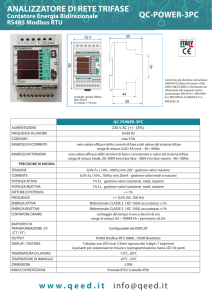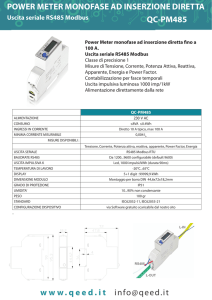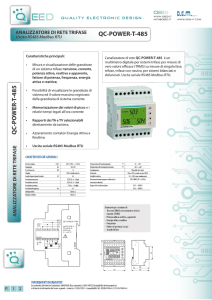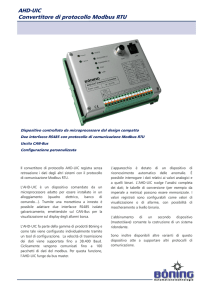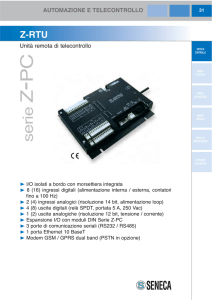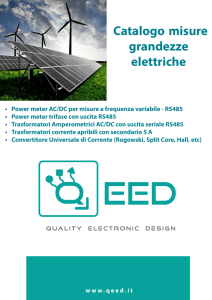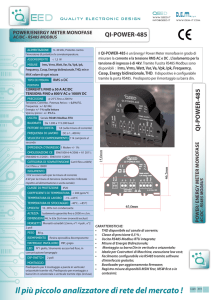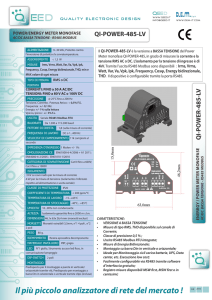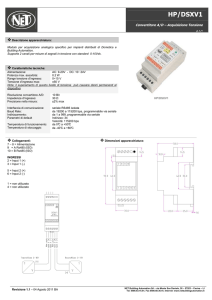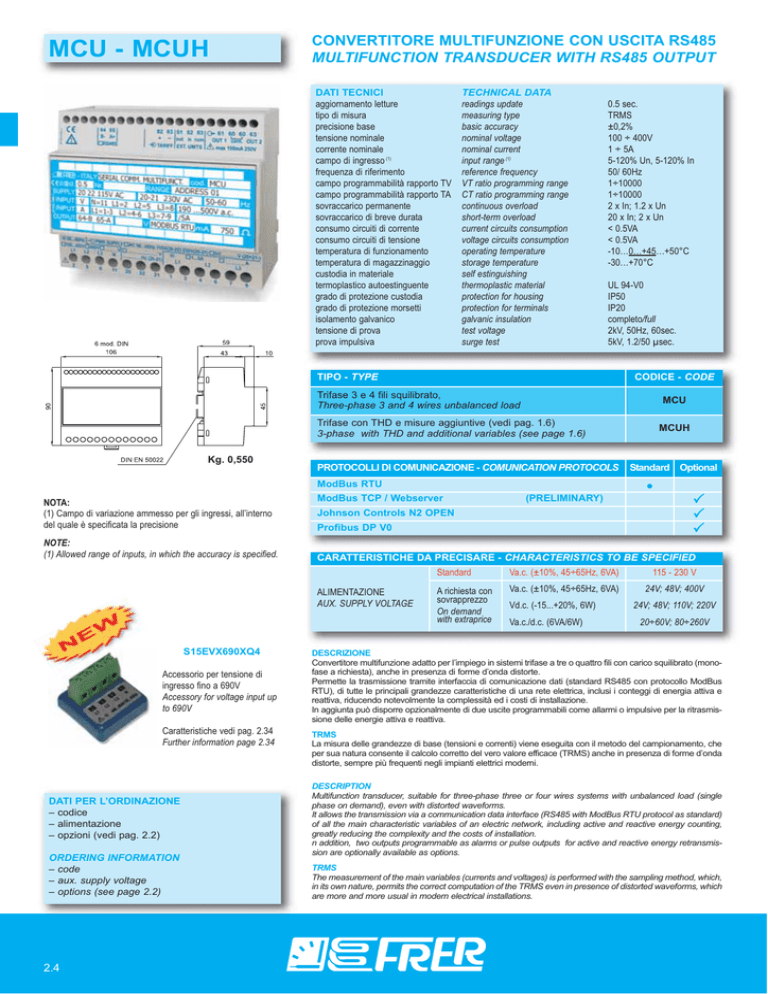
MCU - MCUH
CONVERTITORE MULTIFUNZIONE CON USCITA RS485
MULTIFUNCTION TRANSDUCER WITH RS485 OUTPUT
DATI TECNICI
aggiornamento letture
tipo di misura
precisione base
tensione nominale
corrente nominale
campo di ingresso (1)
frequenza di riferimento
campo programmabilità rapporto TV
campo programmabilità rapporto TA
sovraccarico permanente
sovraccarico di breve durata
consumo circuiti di corrente
consumo circuiti di tensione
temperatura di funzionamento
temperatura di magazzinaggio
custodia in materiale
termoplastico autoestinguente
grado di protezione custodia
grado di protezione morsetti
isolamento galvanico
tensione di prova
prova impulsiva
TECHNICAL DATA
readings update
measuring type
basic accuracy
nominal voltage
nominal current
input range (1)
reference frequency
VT ratio programming range
CT ratio programming range
continuous overload
short-term overload
current circuits consumption
voltage circuits consumption
operating temperature
storage temperature
self estinguishing
thermoplastic material
protection for housing
protection for terminals
galvanic insulation
test voltage
surge test
0.5 sec.
TRMS
±0,2%
100 ÷ 400V
1 ÷ 5A
5-120% Un, 5-120% In
50/ 60Hz
1÷10000
1÷10000
2 x In; 1.2 x Un
20 x In; 2 x Un
< 0.5VA
< 0.5VA
-10…0…+45…+50°C
-30…+70°C
UL 94-V0
IP50
IP20
completo/full
2kV, 50Hz, 60sec.
5kV, 1.2/50 µsec.
TIPO - TYPE
CODICE - CODE
Trifase 3 e 4 fili squilibrato,
Three-phase 3 and 4 wires unbalanced load
MCU
Trifase con THD e misure aggiuntive (vedi pag. 1.6)
3-phase with THD and additional variables (see page 1.6)
Kg. 0,550
PROTOCOLLI DI COMUNICAZIONE - COMUNICATION PROTOCOLS
ModBus RTU
NOTA:
(1) Campo di variazione ammesso per gli ingressi, all’interno
del quale è specificata la precisione
NOTE:
(1) Allowed range of inputs, in which the accuracy is specified.
ModBus TCP / Webserver
Johnson Controls N2 OPEN
Profibus DP V0
Accessorio per tensione di
ingresso fino a 690V
Accessory for voltage input up
to 690V
Caratteristiche vedi pag. 2.34
Further information page 2.34
DATI PER L’ORDINAZIONE
– codice
– alimentazione
– opzioni (vedi pag. 2.2)
ORDERING INFORMATION
– code
– aux. supply voltage
– options (see page 2.2)
2.4
2.4
Standard Optional
•
CARATTERISTICHE DA PRECISARE - CHARACTERISTICS TO BE SPECIFIED
ALIMENTAZIONE
AUX. SUPPLY VOLTAGE
S15EVX690XQ4
(PRELIMINARY)
MCUH
Standard
Va.c. (±10%, 45÷65Hz, 6VA)
A richiesta con
sovrapprezzo
On demand
with extraprice
Va.c. (±10%, 45÷65Hz, 6VA)
Vd.c. (-15...+20%, 6W)
Va.c./d.c. (6VA/6W)
115 - 230 V
24V; 48V; 400V
24V; 48V; 110V; 220V
20÷60V; 80÷260V
DESCRIZIONE
Convertitore multifunzione adatto per l’impiego in sistemi trifase a tre o quattro fili con carico squilibrato (monofase a richiesta), anche in presenza di forme d’onda distorte.
Permette la trasmissione tramite interfaccia di comunicazione dati (standard RS485 con protocollo ModBus
RTU), di tutte le principali grandezze caratteristiche di una rete elettrica, inclusi i conteggi di energia attiva e
reattiva, riducendo notevolmente la complessità ed i costi di installazione.
In aggiunta può disporre opzionalmente di due uscite programmabili come allarmi o impulsive per la ritrasmissione delle energie attiva e reattiva.
TRMS
La misura delle grandezze di base (tensioni e correnti) viene eseguita con il metodo del campionamento, che
per sua natura consente il calcolo corretto del vero valore efficace (TRMS) anche in presenza di forme d’onda
distorte, sempre più frequenti negli impianti elettrici moderni.
DESCRIPTION
Multifunction transducer, suitable for three-phase three or four wires systems with unbalanced load (single
phase on demand), even with distorted waveforms.
It allows the transmission via a communication data interface (RS485 with ModBus RTU protocol as standard)
of all the main characteristic variables of an electric network, including active and reactive energy counting,
greatly reducing the complexity and the costs of installation.
n addition, two outputs programmable as alarms or pulse outputs for active and reactive energy retransmission are optionally available as options.
TRMS
The measurement of the main variables (currents and voltages) is performed with the sampling method, which,
in its own nature, permits the correct computation of the TRMS even in presence of distorted waveforms, which
are more and more usual in modern electrical installations.
MCU - MCUH
CONVERTITORE MULTIFUNZIONE CON USCITA RS485
MULTIFUNCTION TRANSDUCER WITH RS485 OUTPUT
Dati tecnici aggiuntivi
conteggio delle energie
conteggio massimo
classe di precisione
bidirezionalità
uscite allarme
ritardo di attivazione
programmabilità
Additional technical data
energy counting
maximum counting
accuracy class
bidirectionality
alarm outputs
activation delay setting
programmability
uscite impulsive
pulse outputs
programmabilità
durata impulso
ModBus RTU
interfaccia
velocità (bps)
parametri di comunicazione
campo di indirizzamento
ModBus TCP / Webserver
interfaccia Ethernet
velocità
duplex
Johnson Controls N2 OPEN
interfaccia
velocità (bps)
parità
campo di indirizzamento
ProfiBus DP V0
rete
baudrate
campo di indirizzamento
conforme a
programmability
pulse duration
kWh e/and kVarh
99999999 MWh/MVArh
2 (kWh), 3 (kVArh)
si / yes (kWh+ / kWh-)
Photo-mos 250V, 100mA
programm. 0...99 sec.
variabile, valore, direzione
variable, value, direction
programmabile in alternativa agli allarmi
programmable as alternative to alarms
peso impulso / pulse value
Progr. 30...1000 msec.
interface
speed (bps)
communication parameters
addressing range
RS485 isolata/insulated
9600/19200 (38400 solo/only MCUH)
1,8,N,2/1,8,E,1/1,8,O,1
1…247 programm.
Ethernet interface
speed
duplex
IEEE 802.3(u) 10 Base T / 100 Base TX
10/100 Mbit/s auto-negotiation
half/full auto-negotiation
interface
speed (bps)
parity
addressing range
RS485 isolata/insulated
9600
none
1…247 programm.
network
baudrate
addressing range
complies to
NRZ asincrona/asynchronous
9.6kbit/s...12Mbit/s
1…99 programm.
EN 50170
GRANDEZZE MISURATE - MEASURED VARIABLES
TIPO - TYPE
NOTE:
- I valori della corrente e della potenza media sono calcolati
in base ad un tempo (periodo di integrazione) programmabile tra 1 e 60 minuti.
- Nella versione monofase le grandezze misurate sono
quelle relative alla fase L1.
NOTES:
- Average current and average active power values are
calculated considering a time period (integration period)
programmable between 1 and 60 minutes.
- In the single-phase version the measured variables are
those of phase L1.
Fasi visualizzate
individualmente
Phases individually
displayed
Calcolo e
visualizzazione
valori trifase
Calculation
and display
3-phase values
Corrente di linea / Line current
L1, L2, L3
––
Tensione di fase L-N / Star voltage L-N
L1, L2, L3
––
Tensione concatenata L-L / Delta voltage L-L
L1, L2, L3
––
––
somma / sum
Potenza attiva / Active power
Potenza reattiva / Reactive power
––
somma / sum
Fattore di potenza / Power factor
L1, L2, L3
media / average
L1
––
Frequenza / Frequency
L1, L2, L3
––
Potenza attiva media / Average active power
––
somma / sum
Max. corrente media / Max. average current
L1, L2, L3
––
Punta massima (kW) / Max. demand (kW)
––
somma / sum
Energia attiva (kWh+ / kWh-) / Active energy (kWh+ / kWh-)
––
somma / sum
Energia reattiva (kvarh+ / kvarh-) / Reactive energy (kvarh+ / kvarh-)
––
somma / sum
Corrente media / Average current
MISURE ADDIZIONALI E CONTEGGIO DELLE ENERGIE
Oltre alla misura di tutte le principali grandezze caratteristiche della rete elettrica, questi
strumenti calcolano e forniscono anche delle informazioni addizionali molto utili quali: il
valore medio della corrente (corrente termica), il valore massimo raggiunto dalla corrente
termica, il valore medio della potenza attiva, la punta massima (il valore massimo
raggiunto dalla potenza attiva media), l'energia attiva (kWh) e quella reattiva (kVArh).
Il valore medio della corrente ed il valore massimo raggiunto dalla corrente media simulano rispettivamente l'indice nero e quello rosso di un amperometro a bimetallo.
ADDITIONAL VARIABLES AND ENERGY COUNTING
In addition to the measurement of the main characteristics variables of the electric network,
these instruments calculate and provide additional information such as: the average
current (thermal current), the maximum value reached by the thermal current, the average
active power, the maximum demand (maximum value reached by the average active
power), the active (kWh) and reactive (kVArh) energy
The average current indication and the maximum value reached by the average current
simulating the black and the red pointers respectively of a bimetal ammeter.
2.5
MCU - MCUH
CONVERTITORE MULTIFUNZIONE CON USCITA RS485
MULTIFUNCTION TRANSDUCER WITH RS485 OUTPUT
MISURE AGGIUNTIVE PER MCUH - ADDITIONAL VARIABLES FOR MCUH
TIPO - TYPE
Corrente di neutro / Neutral current
Cosφ (sfasamento tra I e V / Displacement power factor)
Fasi visualizzate
individualmente
Phases individually
displayed
Calcolo e
visualizzazione
valori trifase
Calculation
and display
3-phase values
––
N
L1, L2, L3
sistema / system
––
arc tan kvarh+: kwh+
THDV (% nom.)
L1, L2, L3
––
THDI (% nom.)
L1, L2, L3
––
THDV (% RMS o fondamentale/or Fundamental)
L1, L2, L3
––
THDI (% RMS o fondamentale/or Fundamental)
L1, L2, L3
––
––
––
Fattore di potenza medio / Average power factor
Ore di funzionamento / Total hours run
Fattore di cresta I e V / I and V crest factor
L1, L2, L3
––
Sequenza fasi / Phase sequence
––
RST - RTS
Armoniche individuali fino alla 30^
Individual harmonics up tu 30th
L1, L2, L3
––
MISURE AGGIUNTIVE NELLA VERSIONE MCUH
La versione MCUH dispone di un set aggiuntivo di misure "avanzate" che permettono un monitoraggio più efficiente, o che forniscono indicazioni supplementari sullo stato di funzionamento del
sistema. Alcune di esse sono di nuova concezione, altre sono legate a nuove problematiche di
impianto non riscontrabili in passato.
- Corrente di neutro: ricavata tramite somma vettoriale delle correnti di fase (non richiede un TA
aggiuntivo sul conduttore di neutro), indica una cattiva distribuzione dei carichi sulle tre fasi e la
presenza di carichi distorcenti.
- Cosφ: chiamato anche D.P.F. (displacement power factor), indica il reale sfasamento tra
tensione e corrente introdotto da carichi capacitivi o induttivi. Non deve essere confuso con il P.F.
(power factor o fattore di potenza) che viene influenzato dalla distorsione
armonica e che quindi indurrebbe a rifasare anche quando il suo valore si abbassa a causa della
distorsione armonica stessa e non a causa di carichi sfasanti.
- Fattore di potenza medio: è ricavato dai conteggi delle energie attiva e reattiva e serve per verificare il corretto dimensionamento e funzionamento dell'impianto di rifasamento.
- THD: Distorsione armonica totale, indicata come percentuale del valore RMS oppure della
fondamentale. Per evitare che elevati valori di distorsione armonica, ma in corrispondenza di
consumi molto bassi, inducano ad allarmismi ingiustificati, il valore di distorsione armonica viene
visualizzato anche come percentuale del valore nominale, inquadrandolo così in un contesto più
corretto.
- Ore totali, parziali e mancanti alla manutenzione.
- Fattore di cresta: Indica il rapporto tra valore di picco e valore efficace. Vale 1,41 per la sinusoide perfetta, ed il suo valore cambia in funzione della distorsione armonica. Può indicare
problemi dovuti a saturazioni di varia natura causati da valori di picco elevati mascherati da un
valore efficace contenuto.
- Sequenza delle fasi: indica la corretta sequenza L1-L2-L3 (R-S-T), particolarmente utile in caso
di frequenti allacciamenti e disallacciamenti dalla rete.
ADDITIONAL MEASUREMENTS OF THE MCUH
The MCUH version is fitted with an extra measurements pack that permits a more efficient monitoring and gives additional information about the operating conditions of the system. Some of
these measurements are new conceiving while some other are related to the new system set of
problems which were not notable in the past.
- Neutral Current: it is calculated as the vectorial sum of the line currents (it does not require an
additional CT on the neutral wire). It indicates a bad distribution of the loads on the three phases
and the presence of distorting loads in the system.
- Cosφ: it is also called D.P.F. (Displacement Power Factor). It indicates the real phase displacement between voltage and current because of the capacitive or the inductive loads. It has not to
be mixed up with the P.F. (Power Factor) which is affected by the harmonic distortion: as a matter
of fact this would induce to operate a power factor correction even when its value is dropping
because of the harmonic distortion and not
because of displacing loads.
- Average Power Factor: It is calculated by the active and the reactive energy counting. It is very
useful to verify if the power factor correction system functioning and design are correct.
- THD: Total Harmonic Distortion, it is indicated as a percentage of the RMS or fundamental value.
To avoid that high values of harmonic distortion, in case of very low consumptions, induce to unjustified alert conditions, the total harmonic distortion is displayed also as percentage of the nominal value.
- Total and partial hour counting and remaining hours before maintenance.
- Crest Factor: it is the ratio between the peak value and the RMS value. It is 1,41 for the perfect
sinusoidal wave. This value changes depending on the harmonic distortion. It may represent different types saturation problems caused by high peak values hidden by a moderate RMS value.
- Phase sequence: it shows the right phase sequence L1 - L2 - L3 (R-S-T). It is an useful tool in
case of frequent connections and disconnections from networks.
2.6
2.6
MCU - MCUH
per linea monofase
for single-phase
CONVERTITORE MULTIFUNZIONE CON USCITA RS485
MULTIFUNCTION TRANSDUCER WITH RS485 OUTPUT
INTERFACCIA DATI
Per l’interfacciamento degli strumenti a sistemi di supervisione o di gestione dell’energia,
sono disponibili opzionalmente le più diffuse tipologie di interfaccia/protocollo utilizzate
oggigiorno. Esse sono:
Interfaccia seriale RS485 con protocollo ModBus RTU (di serie). Su una stessa linea
RS485 possono essere collegati fino a 32 strumenti (128 con l'opzione 1/4 unit load),
coprendo una distanza massima di 1200 metri.
Interfaccia Ethernet 10/100 con protocollo ModBus/TCP e web server, per l’integrazione in una rete LAN o WAN e la lettura delle misure anche via Internet tramite un
semplice web browser.
RS485 con protocollo N2 Open, per l’integrazione in sistemi Johnson Controls.
Profibus DP-V0, lo standard industriale per la comunicazione ad alta velocità nei sistemi
di automazione e di processo.
Particolare cura è stata posta nell’ottimizzazione dei dati da trasmettere, in modo da
poter ottenere un quadro sintetico ma completo della situazione del sistema con
pacchetti dati molto compatti, pur conservando la possibilità di scegliere quali misure, tra
tutte quelle eseguite dagli strumento, includere nella trasmissione.
USCITE DI ALLARME ED USCITE IMPULSIVE
Sono disponibili fino a 4 uscite di allarme (opzionali), utilizzabili per controllare l’andamento di specifiche grandezze misurate. La loro programmazione consente di stabilire la
modalità di funzionamento (di minima, di massima o come watch-dog), quale è la variabile controllata, il suo livello di soglia ed il ritardo di intervento.
Nel caso in cui le variabili controllate siano delle tensioni o delle correnti, l’allarme agisce
in modalità trifase, cioè interviene se una qualsiasi delle tre fasi supera il livello di soglia
prestabilito. In tutti gli altri casi invece la grandezza controllata è quella di sistema
(somma o media delle singole fasi).
In alternativa è possibile ritrasmettere, tramite due uscite, i conteggi delle energie ad
unità remote quali contaimpulsi esterni, PLC, etc.
Il peso dell’impulso è programmabile in modo diretto, es. 1 impulso = …kWh, in modo
indipendente tra energia attiva e reattiva.
per linea trifase a tre fili
for three-phase three wires system
per linea trifase a quattro fili
for three-phase four wires system
DATA INTERFACE
It is possible to interface the meters to supervision systems or to energy management
system by means of the most common interface protocol types. They are:
Serial interface RS485 with Modbus RTU protocol (always supplied). On the same bus
it is possible to connect up to 32 meters (128 units with the ¼ unit load option) and with
a max distance at 1200 meters.
Ethernet 10/100 interface with Modbus/TCP and web server. It permits the integration
to a LAN or WAN network and the measurement reading via Internet by means of a web
brouser.
RS485 with N2 open protocol for the integration to Johnson Controls systems.
Profibus DP-V0: the industrial application for the high speed communication in the automation and process systems.
A particular care has been adopted while optimizing the data to be transmitted, with the
aim to get a synthetized but complete picture of the system situation by means of very
compact data files. Anyway it is still possible included in the transmission among the available ones.
ALARM AND PULSES OUTPUTS
Four alarm outputs (optional) are available to control the behaviour of specific measured
variables. It is possible to define the functioning mode (as minimum or maximum level or
as a watch-dog), the controlled variable type, the alarm value and the activation delay.
When monitoring currents or voltages, the alarms work in three-phase mode, that is they
activate the output relays when one of the three phases crosses the set point; in all other
cases the controlled variable is the one of the system (sum or average of the different
phases).
As alternative it is possible to retransmit, via two outputs, the energy counting to remote
units as external pulses counters, PLC and so on. The pulse value is directly programmable i.e. 1 pulse = …kWh, independently for active and reactive energy.
2.7

